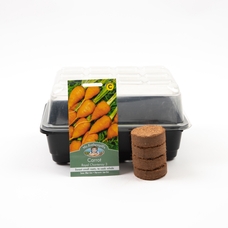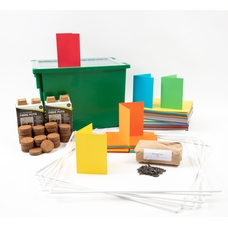Seasonal Growing Set by Hope Education - Spring
Seasonal Growing Set by Hope Education - Spring
Product code: CP056804
Product Description
Embark on an exploration of the natural world with our Spring Nature Kit, developed by Hope Education. This kit includes four captivating, hands-on lessons, designed to nurture a love for nature in students.
Featuring four engaging activities, perfect to do during spring. The kit is a green thumb guarantee for your classroom. Each activity not only sparks curiosity but also fosters a deep connection with the environment. Infused with educational value and entertainment, these experiences effortlessly transform traditional teaching into an unforgettable immersive journey of discovery.
Aligned with the national curriculum objectives, this kit is a comprehensive resource that equips educators with everything (apart from a few basics) they need to seamlessly integrate nature-based learning into their classroom. From detailed lesson plans to worksheets, we've taken care of the essentials, allowing you to focus on cultivating a vibrant, interactive learning environment.
Unleash the wonders of the great outdoors and watch as your students blossom with newfound knowledge and enthusiasm for the world around them. The Spring Nature Kit is your passport to an educational adventure like no other.
Activities included:
- Create Clay Flowers
- Growing Cress
- Make Newspaper Pots
- Make Wildflower Seed Bombs
What’s in the box:
- Lesson plans x 4
- Paper pot makers x 6
- 30 packs of cress seeds
- Coir pellets x 40
- Plant growth tracking worksheet
- Green modelling clay 500g x 3
- Yellow modelling clay 500g x 3
- Orange modelling clay 500g x 3
- Cerise modelling clay 500g x 5
- Blue modelling clay 500g x 3
- Powdered Clay 1kg
- Box of wildflower seeds
- Gardening tasks worksheet
- Deep Gratnells tray with lid
- Jumbo Gratnells tray with lid
Items may vary due to stock availability
Living things and their habitats
- Identify and describe the basic structure of a variety of common flowering plants, including trees.
- Observe and describe how seeds and bulbs grow into mature plants.
- Explore the requirements of plants for life and growth (air, light, water, nutrients from soil, and room to grow) and how they vary from plant to plant.
- Investigate the way in which water is transported within plants.
- Explore the part that flowers play in the life cycle of flowering plants, including pollination, seed formation, and seed dispersal.
- Identify and name a variety of common wild and garden plants, including deciduous and evergreen trees.
- Pupils should be introduced to the idea that all living things have certain characteristics that are essential for keeping them alive and healthy.
- Pupils should use the local environment throughout the year to explore and answer questions about plants growing in their habitat. Where possible, they should observe the growth of flowers and vegetables that they have planted.
- Pupils should be taught to observe and describe how seeds and bulbs grow into mature plants.
- Pupils should be taught to find out and describe how plants need water, light and a suitable temperature to grow and stay healthy.
- They should become familiar with common names of flowers, examples of deciduous and evergreen trees, and plant structures (including leaves, flowers (blossom), petals, fruit, roots, bulb, seed, trunk, branches, stem).
- Pupils should use the local environment throughout the year to observe how plants grow. Pupils should be introduced to the requirements of plants for germination, growth and survival, as well as the processes of reproduction and growth in plants. (Note: seeds and bulbs need water to grow but most do not need light; seeds and bulbs have a store of food inside them.)
- Pupils might work scientifically by: observing and recording, with some accuracy, the growth of a variety of plants as they change over time from a seed or bulb, or observing similar plants at different stages of growth; setting up a comparative test to show that plants need light and water to stay healthy.
- Identify and describe the basic structure of a variety of common animals, including humans.
Materials
- Distinguish between an object and the material from which it is made.
- Find out how the shapes of solid objects made from some materials can be changed by squashing, bending, twisting and stretching.
- They should think about the properties of materials that make them suitable or unsuitable for particular purposes and they should be encouraged to think about unusual and creative uses for everyday materials.
- Identify and name a variety of everyday materials, including wood, plastic, glass, metal, water, and rock.
- Describe the simple physical properties of a variety of everyday materials.
- Compare and group together a variety of everyday materials based on their simple physical properties.
Further Information
- Age Recommended from
- 3 Years
- Age Suitability Message
- WARNING: Not suitable for children under 36 months due to small parts that may present a choking hazard.
- Age Suitable from
- 3 Years
- Brand
- Hope Education
- Key Stage
- Key Stage 1Key Stage 2
Documents
Embark on an exploration of the natural world with our Spring Nature Kit, developed by Hope Education. This kit includes four captivating, hands-on lessons, designed to nurture a love for nature in students.
Featuring four engaging activities, perfect to do during spring. The kit is a green thumb guarantee for your classroom. Each activity not only sparks curiosity but also fosters a deep connection with the environment. Infused with educational value and entertainment, these experiences effortlessly transform traditional teaching into an unforgettable immersive journey of discovery.
Aligned with the national curriculum objectives, this kit is a comprehensive resource that equips educators with everything (apart from a few basics) they need to seamlessly integrate nature-based learning into their classroom. From detailed lesson plans to worksheets, we've taken care of the essentials, allowing you to focus on cultivating a vibrant, interactive learning environment.
Unleash the wonders of the great outdoors and watch as your students blossom with newfound knowledge and enthusiasm for the world around them. The Spring Nature Kit is your passport to an educational adventure like no other.
Activities included:
- Create Clay Flowers
- Growing Cress
- Make Newspaper Pots
- Make Wildflower Seed Bombs
What’s in the box:
- Lesson plans x 4
- Paper pot makers x 6
- 30 packs of cress seeds
- Coir pellets x 40
- Plant growth tracking worksheet
- Green modelling clay 500g x 3
- Yellow modelling clay 500g x 3
- Orange modelling clay 500g x 3
- Cerise modelling clay 500g x 5
- Blue modelling clay 500g x 3
- Powdered Clay 1kg
- Box of wildflower seeds
- Gardening tasks worksheet
- Deep Gratnells tray with lid
- Jumbo Gratnells tray with lid
Items may vary due to stock availability
Living things and their habitats
- Identify and describe the basic structure of a variety of common flowering plants, including trees.
- Observe and describe how seeds and bulbs grow into mature plants.
- Explore the requirements of plants for life and growth (air, light, water, nutrients from soil, and room to grow) and how they vary from plant to plant.
- Investigate the way in which water is transported within plants.
- Explore the part that flowers play in the life cycle of flowering plants, including pollination, seed formation, and seed dispersal.
- Identify and name a variety of common wild and garden plants, including deciduous and evergreen trees.
- Pupils should be introduced to the idea that all living things have certain characteristics that are essential for keeping them alive and healthy.
- Pupils should use the local environment throughout the year to explore and answer questions about plants growing in their habitat. Where possible, they should observe the growth of flowers and vegetables that they have planted.
- Pupils should be taught to observe and describe how seeds and bulbs grow into mature plants.
- Pupils should be taught to find out and describe how plants need water, light and a suitable temperature to grow and stay healthy.
- They should become familiar with common names of flowers, examples of deciduous and evergreen trees, and plant structures (including leaves, flowers (blossom), petals, fruit, roots, bulb, seed, trunk, branches, stem).
- Pupils should use the local environment throughout the year to observe how plants grow. Pupils should be introduced to the requirements of plants for germination, growth and survival, as well as the processes of reproduction and growth in plants. (Note: seeds and bulbs need water to grow but most do not need light; seeds and bulbs have a store of food inside them.)
- Pupils might work scientifically by: observing and recording, with some accuracy, the growth of a variety of plants as they change over time from a seed or bulb, or observing similar plants at different stages of growth; setting up a comparative test to show that plants need light and water to stay healthy.
- Identify and describe the basic structure of a variety of common animals, including humans.
Materials
- Distinguish between an object and the material from which it is made.
- Find out how the shapes of solid objects made from some materials can be changed by squashing, bending, twisting and stretching.
- They should think about the properties of materials that make them suitable or unsuitable for particular purposes and they should be encouraged to think about unusual and creative uses for everyday materials.
- Identify and name a variety of everyday materials, including wood, plastic, glass, metal, water, and rock.
- Describe the simple physical properties of a variety of everyday materials.
- Compare and group together a variety of everyday materials based on their simple physical properties.
Further Information
- Age Recommended from
- 3 Years
- Age Suitability Message
- WARNING: Not suitable for children under 36 months due to small parts that may present a choking hazard.
- Age Suitable from
- 3 Years
- Brand
- Hope Education
- Key Stage
- Key Stage 1Key Stage 2



